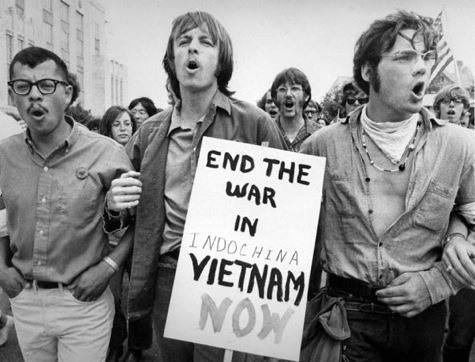Vietnam: The Outbreak
WARNING: GRAPHIC
 |
| The picture above is the map of Vietnam before the war. Vietnam was split at the 37th parallel. The Viet Kong used Laos and Cambodia to filter goods into Sough Vietnam for rebels. |
The Outbreak
Vietnam was split into two parts after the Geneva Accord, similar to Korea in WWII. The northern half was given to the Soviet Union, while the southern half was given to the U.S. While the U.S.S.R. gave their power to Ho Chi Minh, while the southern election gave Diem a chance to rise to power. Diem and his brother, who ran the secret service, ran the southern half with an iron fist. The U.S. disagreed with his type of rule, and let an assassination plot usurp Diem. With Diem's regime terrorized Vietnam, Ho Chi Minh invaded south Vietnam, planning to unite Vietnam once again.
U.S. Involvement in the War
 |
| this is a propaganda poster from North Vietnam. It states that "The Vietnamese people must resist the American aggressor".Many North Vietnamese saw the U.S. as an oppressor of South Vietnam. |
The U.S. was occupying South Vietnam with thousands of 'military advisers' 'advising' Diem and his regime. The North Vietnamese army began to try and invade South Vietnam, trying to reunite Vietnam once again. After an 'incident' in the Gulf on Tongkin, Lyndon B Johnson had full power to use U.S. troops in Vietnam. With these troops, Lyndon fought the Viet Kong with the might of the U.S. military. Because of the high temperatures and humidity, all soldiers were required to take salt tablets, otherwise they could not sweat. President Johnson allowed an experiment take place with the soldiers, giving many of them heroin to see the stages of addiction. However, after returning from the war most of the soldiers went drug free for the rest of their lives.
Setting
| The picture above shows the mountainous terrain the U.S. soldiers had to deal with. Many soldiers had to deal with always being in contact with water. This would lead to 'jungle rot'. |
Vietnam is not a place U.S. soldiers had ever experienced before. The land was very mountainous, making it hard to use transportation to move soldiers quickly. The monsoon season took up half of the year, flooding most of Vietnam. The hot temperatures and high humidity combined made the region quite inhospitable for people wearing full armor, requiring many soldiers to take salt tablets to keep sweating. The entirety of Vietnam was covered in rain forest, raining as many as 5 times a day. the forestry was so awful that it was near impossible to see the ground, 10 feet in front of you, or sometimes even the sky.
On the Home-front
 |
| The college student above are protesting the war in Vietnam. The students are liking arms, probably facing U.S. MP's in front of them. They are chanting something together. |
Many college student disagreed with the war. Plenty of protests took place in college, protesting the war and U.S. involvement. Many protesters were shot after assaulting the police trying to withhold the mob. Most of the mobs were college students- people with nothing to lose. While many dodged the draft, others looked at other ways to avoid going to Vietnam. Some of the examples were temporarily immigrating to Canada, creating a community away from society, and moving away from the U.S. Even if the soldiers were drafted,many people hated them. When soldiers returned, they returned to hordes calling them awful people and spitting on them.
The end of the War
With the mass civil upset across the United States, The U.S. joined with Ho Chi Minh to discuss U.S. withdrawal. An agreement was reached: The U.S. would begin to withdraw troops if the Viet kong would restrict their invading forces to 70,000 troops. When the U.S. began to pull troops, South Vietnamese people were not happy. Many tried to get their children sent to the U.S., believing they would have a happier life there than under Viet Kong Rule. Two weeks after the U.S. fully withdrew from Vietnam, Saigon was captured by Viet Kong forces.


No comments:
Post a Comment